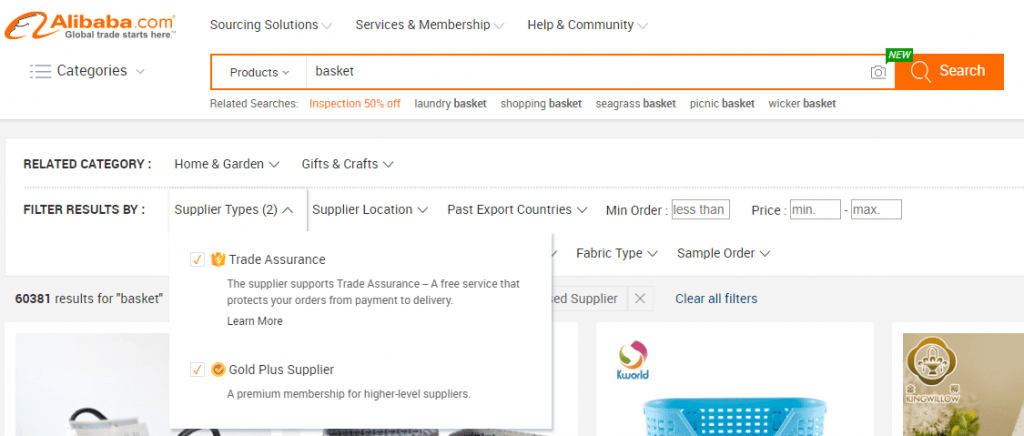Although multiple resources exist to source cheaply manufactured products, one company, Alibaba is head and shoulders above the rest.
They are a gigantic online Chinese marketplace with millions of sellers and tens of millions of products available to customise and purchase.
If you can’t find a product on Alibaba, chances are it doesn’t exist.
Important: Don’t get confused with Alibaba Express. This is a different marketplace which allows for smaller orders but costs more per unit and doesn’t allow for custom branding. It therefore, is no help to an Amazon private label seller.
Once you create a free account with Alibaba you can begin contacting suppliers. Here are the steps:
1. Research & Reach Out
Begin by narrowing down potential suppliers by the following filters:
- Trade Assurance – this is a free service offered by Alibaba.com. It covers buyers with 100% payment protection if the terms of the contract are not met.
- Gold Plus Suppliers – Suppliers must work hard to earn the gold badge and membership is expensive. This alone offers a baseline protection against dodgy factories.
These two filters will greatly reduce the risk of dealing with dodgy factories and provide you with a list of top-notch suppliers.
At this point you can either post a Request for Quotation (RFQ) within your Alibaba account. After which, suppliers will contact you with a detailed quote for your requested product and specifications.
Or you can manually browse through the filtered suppliers and inspect their current products before approaching them with a RFQ.
If you choose to approach suppliers with a RFQ, you will need to write up a pro forma email. You can then customise and send it to every supplier you wish to gather information from.
This email should include requests for the following information:
- Minimum Order Quantities (MOQ)
- Ability to customise / Add logo
- Product materials and the manufacturing process
- Quality assurance measures
- Price per unit
- Order lead times
- Returns policy for defective products
- Deposit amount
- Payment terms and payment methods
- Shipping estimates (both to the Chinese port and to the Amazon Fulfilment Centre)
- Sample cost and lead time
- Sample cost refundable if a follow-up order is made
- Total order cost including shipping
The email should also contain all of your company details, product requirements, photographs of similar designs and any other pertinent information. Be very specific and precise with any descriptions and requests to avoid any issues down the track.
Remember to keep all email communications easy to understand but also professional.
It is important to remain respectful during the initial negotiations. Don’t press them too hard on price because it will not go down well. Remember these factories need to maintain profit margins themselves.
Overtime, once a strong personal and business relationship has developed, you can continue to negotiate the price down further. These mutually beneficial relationships are the cornerstone of Chinese business and referred to as “Guanxi”.
2. Due Diligence
Usually after filtering product searches by Gold Suppliers and Trade Assurance, the risk of dealing with a dodgy factory is massively reduced.
However, if you want to be particularly careful you can use the following strategies:
- Online research – conduct a simple Google search of the company. Any decent supplier will have some sort of web presence. You will also uncover any warnings from other sellers that have dealt with them in the past.
- Ask very detailed questions – after the initial RFQ, send through some very specific questions and see how they address them.
- Ask for pictures – any decent supplier will be able to provide pictures of their factory and products. In fact they should already have them ready to send.
- Get a sample before you buy – this is Private Label Seller 101 and an industry standard. Any supplier that wont provide a sample should be avoided.
- Request a factory visit – even if you don’t plan to follow through, it will generate a tell-tail reaction from the supplier. A dodgy factory will try to avoid it like the plague, whilst a good supplier will welcome it.
3. Order & Test Samples
After receiving answers to the RFQ emails and completing the due diligence, you can select the top factories and order samples.
Samples from multiple suppliers is a must. Never put all your eggs in one basket. You will be shocked at the quality difference between suppliers.
When ordering samples, sellers are usually expected to pay a small sample fee and shipping. This is usually refunded after a full order is placed.
Paypal is usually the best option to pay for the sample due to their strong buyer protection.
Once the samples arrive they should be thoroughly tested and inspected by multiple people, to ensure the quality is up to scratch. You should also photograph them to see how they look in pictures!
4. Place First Order
Once you have a complete understanding and agreement on the product design, product cost, order quantity and shipping terms, you can place the first order.
Before you place the order though you should:
- Request a detailed quotation to review
- Confirm they understand Amazon FBA and the packaging requirements
- Confirm the terms for faulty products
- Confirm shipping time frames
- Confirm lead time on new orders (very important for inventory forecasting)
I would recommend paying via Paypal. It is a very safe way of dealing with Chinese suppliers.
There are a multitude of other ways to pay suppliers, most of which are cheaper but are also inherently riskier. E.G. Western Union or Telegraphic Transfer (TT).
For peace of mind, especially during the early stages of a new business relationship, I would use Paypal.
Finally, as you are shipping directly from China to the USA, you will have to instruct the manufacturer to ship your products according to Amazon FBA specifications.
You will also need to provide them with shipping labels addressed to the Amazon Fulfilment Centres.
Obviously if you begin trading in other Amazon markets in Australia, Europe or elsewhere, then you will need to send them different labels for those locations.


